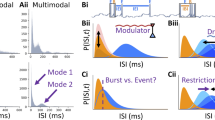Abstract
We describe an approach to analyzing single- and multiunit (ensemble) discharge patterns based on information-theoretic distance measures and on empirical theories derived from work in universal signal processing. In this approach, we quantify the difference between response patterns, whether time-varying or not, using information-theoretic distance measures. We apply these techniques to single- and multiple-unit processing of sound amplitude and sound location. These examples illustrate that neurons can simultaneously represent at least two kinds of information with different levels of fidelity. The fidelity can persist through a transient and a subsequent steady-state response, indicating that it is possible for an evolving neural code to represent information with constant fidelity.
Similar content being viewed by others
References
Abeles M (1991) Corticonics: Neural Circuits of the Cerebral Cortex. Cambridge University Press, New York.
Abeles M, Goldstein Jr. MH (1977) Multispike train analysis. Proc. IEEE 65:762-773.
Alonso JM, Usrey WM, Reid RC (1996) Precisely correlated firing in cells of the lateral geniculate nucleus. Nature 383:815-818.
Basseville M (1989) Distance measures for signal processing and pattern recognition. Signal Processing 18:349-369.
Bialek W, Rieke F, de Ruyter van Steveninck RR, Warland D (1991) Reading a neural code. Science 252:1852-1856.
Carlton AG (1969) On the bias of information estimates. Psychological Bulletin 71:108-109.
Cover TM, Thomas JA (1991) Elements of Information Theory. Wiley, New York.
deCharms RC, Merzenich MM (1996) Primary cortical representation of sounds by the coordination of action-potential timing. Nature 381:610-613.
Efron B, Tibshirani RJ (1993) An Introduction to the Bootstrap. Chapman & Hall, New York.
Fagan RM (1978) Information measures: Statistical confidence limits and inference. J. Theor. Biol. 73:61-79.
Gabbiani F, Koch C (1996) Coding of time-varying signals in spike trains of integrate-and-fire neurons with random threshold. Neural Comput. 8:44-66.
Gardner WA (1994) An introduction to cyclostationary signals. In: Cyclostationarity in Communications and Signal Processing. IEEE Press, New York. chap. 1.
Gruner CM, Johnson DH (1999) Correlation and neural information coding efficiency. In: Computational Neuroscience. Elsevier, Santa Barbara, CA.
Hogg RV, Craig AT (1995) Introduction to Mathematical Statistics (5th ed.). Prentice-Hall, Englewood Cliffs, NJ.
Johnson DH (1996) Point process models of single-neuron discharges. J. Comput. Neurosci. 3:275-299.
Johnson DH, Dudgeon DE (1993) Array Signal Processing: Concepts and Techniques. Prentice-Hall, Englewood Cliffs, NJ.
Johnson DH, Orsak GC (1993) Performance of optimal non-Gaussian detectors. IEEE Trans. Comm. 41:1319-1328.
Johnson DH, Swami A (1983) The transmission of signals by auditory-nerve fiber discharge patterns. J. Acoust. Soc. Am. 74:493-501.
Johnson DH, Tsuchitani C, Linebarger DA, Johnson M (1986) The application of a point process model to the single unit responses of the cat lateral superior olive to ipsilaterally presented tones. Hearing Res. 21:135-159.
Krichevsky RE, Trofimov VK (1981) The performance of universal encoding. IEEE Trans. Info. Theory IT-27:199-207.
Middlebrooks JC, Clock AE, Xu L, Green DM (1994) A panoramic code for sound location by cortical neurons. Science 264:842-844.
Riehle A, Grun S, Diesmann M, Aertsen A (1997) Spike synchronization and rate modulation differentially involved in motor cortical function. Science 278:1950-1953.
Rieke F, Bodnar DA, Bialek W (1995) Naturalistic stimuli increase the rate and efficiency of information transmission by primary auditory efferents. Proc. R. Soc. Lond. B 262:259-265.
Singer W, Gray CM (1995) Visual feature integration and the temporal correlation hypothesis. Ann. Rev. Neurosci. 18:555-586.
Information-Theoretic Analysis of Neural Coding 69 Tsuchitani C (1988a) The inhibition of cat lateral superior olivary unit excitatory responses to binaural tone bursts: I. The transient chopper discharges. J. Neurophysiol. 59:164-183.
Tsuchitani C (1988b) The inhibition of cat lateral superior olivary unit excitatory responses to binaural tone bursts: II. The sustained discharges. J. Neurophysiol. 59:184-211.
Vaadla E, Haalman L, Abeles M, Bergman H, Prut Y, Solvin H, Aertsen A (1995) Dynamics of neuronal interactions in monkey cortex in relation to behavioural events. Nature 373:515-518.
Victor JD, Purpura KP (1997) Metric-space analysis of spike trains: Theory, algorithms and applications. Network: Comput. Neural Sys. 8:127-164.
Wehr M, Laurent, G (1996) Odour encoding by temporal sequences of firing in oscillation neural assemblies. Nature 384:162-166.
Wienberger MJ, Rissanen JJ, Feder M (1995) Auniversal finite memory source. IEEE Trans. Info. Theory 41:643-652.
Zacksenhouse M, Johnson DH, Tsuchitani C (1992) Excitatory/inhibitory interaction in the LSO revealed by point process modeling. Hearing Res. 62:105-123.
Zacksenhouse M, Johnson DH, Tsuchitani C (1993) Excitation effects on LSO unit sustained responses: Point process characterization. Hearing Res. 68:202-216.
Zacksenhouse M, Johnson DH, Williams J, Tsuchitani C (1998) Single-neuron modeling of LSO unit responses. J. Neurophysiol. 79:3098-3110.
Author information
Authors and Affiliations
Rights and permissions
About this article
Cite this article
Johnson, D.H., Gruner, C.M., Baggerly, K. et al. Information-Theoretic Analysis of Neural Coding. J Comput Neurosci 10, 47–69 (2001). https://doi.org/10.1023/A:1008968010214
Issue Date:
DOI: https://doi.org/10.1023/A:1008968010214




